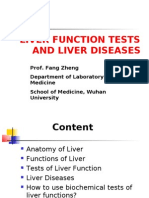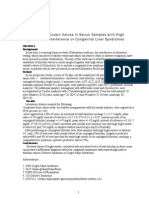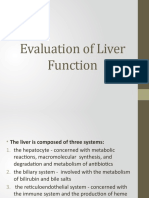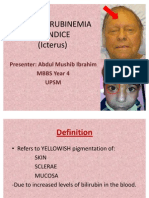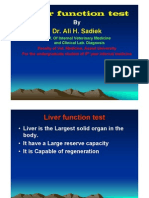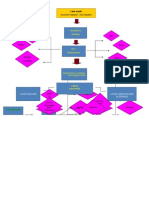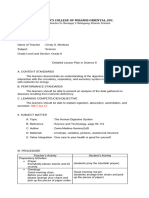Liver Function Tests PDF
Liver Function Tests PDF
Uploaded by
Subhash Digambar VisalCopyright:
Available Formats
Liver Function Tests PDF
Liver Function Tests PDF
Uploaded by
Subhash Digambar VisalOriginal Description:
Original Title
Copyright
Available Formats
Share this document
Did you find this document useful?
Is this content inappropriate?
Copyright:
Available Formats
Liver Function Tests PDF
Liver Function Tests PDF
Uploaded by
Subhash Digambar VisalCopyright:
Available Formats
Liver function tests
Liver function tests
Liver function tests
Intervention ICD-10-PCS K-70 to K-77 ICD-9-CM MeSH 570573 D008111 [1]
MedlinePlus 003436 [2]
Liver function tests (LFTs or LFs), are groups of clinical biochemistry laboratory blood assays designed to give information about the state of a patient's liver.[] The parameters measured include Prothrombin time (PT/INR), aPTT, albumin, bilirubin (direct and indirect) and others. According to someWikipedia:Avoid weasel words, liver transaminases (AST/ALT (SGOT/SGPT) are not liver function tests but liver damage testbiomarkers of liver injury in a patient with some degree of intact liver function.[citation needed] Other sources include transaminases.[][] Most liver diseases cause only mild symptoms initially, but it is vital that these diseases be detected early. Hepatic (liver) involvement in some diseases can be of crucial importance. This testing is performed by a medical technologist on a patient's serum or plasma sample obtained by phlebotomy. Some tests are associated with functionality (e.g., albumin); some with cellular integrity (e.g., transaminase) and some with conditions linked to the biliary tract (gamma-glutamyl transferase and alkaline phosphatase). Several biochemical tests are useful in the evaluation and management of patients with hepatic dysfunction. These tests can be used to (1) detect the presence of liver disease, (2) distinguish among different types of liver disorders, (3) gauge the extent of known liver damage, and (4) follow the response to treatment. Some or all of these measurements are also carried out (usually about twice a year for routine cases) on those individuals taking certain medications anticonvulsants are a notable example in order to ensure that the medications are not damaging the person's liver.
Standard liver panel
Albumin
Reference range 3.5 to 5.3 g/dL
Albumin is a protein made specifically by the liver, and can be measured cheaply and easily. It is the main constituent of total protein (the remaining from globulins). Albumin levels are decreased in chronic liver disease, such as cirrhosis. It is also decreased in nephrotic syndrome, where it is lost through the urine. The consequence of low albumin can be edema since the intra-vascular oncotic pressure is lower than the extravascular space. An alternative to albumin measurements is pre-albumin, which is better at detecting acute changes (half-life of albumin and pre-albumin is ~2 weeks and ~2 days respectively.
Liver function tests
Aspartate transaminase
Reference range 6-40 IU/L [3]
Aspartate transaminase (AST) also called serum glutamic oxaloacetic transaminase (SGOT) or aspartate aminotransferase (ASAT) is similar to ALT in that it is another enzyme associated with liver parenchymal cells. It is raised in acute liver damage, but is also present in red blood cells, and cardiac and skeletal muscle and is therefore not specific to the liver. The ratio of AST to ALT is sometimes useful in differentiating between causes of liver damage.[][] Elevated AST levels are not specific for liver damage, and AST has also been used as a cardiac marker.
Transaminitis
AST/ALT elevations instead of ALP elevations favor liver cell necrosis as a mechanism over cholestasis. When AST and ALT are both over 1000 IU/L, the differential can include acetaminophen toxicity, shock, or fulminant liver failure. When AST and ALT are >3X of normal but not > 1000 IU/L, the differential can include alcohol toxicity, viral hepatitis, drug induced, liver cancer, sepsis, Wilson disease, post-transplant rejection of liver, autoimmune hepatitis, and steatohepatitis (non-alcoholic). When AST/ALT elevated are minor it may be due to rhabdomyolysis among many possibilities.
Alkaline phosphatase
Reference range 30 to 120 IU/L []
Alkaline phosphatase (ALP) is an enzyme in the cells lining the biliary ducts of the liver. ALP levels in plasma will rise with large bile duct obstruction, intrahepatic cholestasis or infiltrative diseases of the liver. ALP is also present in bone and placental tissue, so it is higher in growing children (as their bones are being remodelled) and elderly patients with Paget's disease. In the 3rd trimester of pregnancy, ALP is ~2-3X higher.
Total bilirubin
Reference range 0.11.0mg/dL
Unconjugated Bilirubin is a breakdown product of heme (a part of hemoglobin in red blood cells). Unconjugated bilirubin is very hydrophobic and relies on transportation on albumin that is circulating in the blood. This is why addition of high concentration hydrophobic drugs (certain antibiotics, diuretics) and high free fatty acids can cause elevated unconjugated bilirubin. Heme can also come from myoglobin, found mostly in muscle, cytochromes, found mostly in mitochondria, catalase, peroxidase, and nitric oxide synthase. The liver is responsible for clearing the blood of unconjugated bilirubin and about 30% of bilirubin is taken up by a normal liver each pass through the liver. It does this by the following mechanism: Bilirubin is taken up into hepatocytes, conjugated (modified to make it water-soluble) by UDP-glucuronyl-transferase, and secreted into the bile by CMOAT (MRP2), which is excreted into the intestine. In the intestine, conjugated bilirubin may be (1) metabolized by colonic bacteria, (2) eliminated, (3) reabsorbed. Metabolism of bilirubin into urobilinogen followed by reabsorption of urobilinogen accounts for the yellow color of urine as we urinate a downstream product of urobilinogen. Further metabolism of urobilinogen into stercobilin while in the bowels accounts for the brown color of stool. Thus having white or clay colored stool is an indicator for a blockage in bilirubin processing and thus potential liver dysfunction or cholestatis.
Liver function tests Increased total bilirubin (TBIL) causes jaundice, and can indicate a number of problems: 1. Prehepatic: Increased bilirubin production. This can be due to a number of causes, including hemolytic anemias and internal hemorrhage. 2. Hepatic: Problems with the liver, which are reflected as deficiencies in bilirubin metabolism (e.g., reduced hepatocyte uptake, impaired conjugation of bilirubin, and reduced hepatocyte secretion of bilirubin). Some examples would be cirrhosis and viral hepatitis. 3. Posthepatic: Obstruction of the bile ducts, reflected as deficiencies in bilirubin excretion. (Obstruction can be located either within the liver or in the bile duct).
Direct bilirubin (conjugated bilirubin)
Reference range 0.10.4mg/dL
The diagnosis is narrowed down further by looking at the levels of direct bilirubin. If direct (i.e. conjugated) bilirubin is normal, then the problem is an excess of unconjugated bilirubin (indirect bilirubin), and the location of the problem is upstream of bilirubin conjugation in the liver. Hemolysis, viral hepatitis, or cirrhosis can be suspected. If direct bilirubin is elevated, then the liver is conjugating bilirubin normally, but is not able to excrete it. Bile duct obstruction by gallstones or cancer should be suspected.
Congenital Bilirubin Disorders
About 5% of the population have Gilbert's syndrome, a mutation (or variation) in the UDP-glucuronyl-transferase promotor that manifests itself as jaundice when the individual is stressed (i.e. starves). Autosomal recessive knockouts of UDP-glucuronyl-transferase itself can lead to Crigler-Najjar Syndrome and elevations of unconjugated bilirubin. Defects in CMOAT (MRP2) results in Dubin-Johnson Syndrome and elevations of conjugated bilirubin.
High Bilirubin in neonates
Neonates are especially vulnerable to bilirubin levels due to an immature blood-brain barrier that predisposed them to kernicterus / bilirubin encephalopathy which can result in permanent neurological damage. Neonates also have a low amount of functional UDP-glucuronyl-transferase and can have elevated unconjugated bilirubin since conjugated is limited. For this reason, newborns are often treated with UV light to turn the hydrophobic, albumin-binding unconjugated bilirubin into a form that is more hydrophilic and able to be secreted out via urine, sparing the neonate's brain.
Gamma glutamyl transpeptidase
Reference range 0 to 42 IU/L []
Although reasonably specific to the liver and a more sensitive marker for cholestatic damage than ALP, Gamma glutamyl transpeptidase (GGT) may be elevated with even minor, sub-clinical levels of liver dysfunction. It can also be helpful in identifying the cause of an isolated elevation in ALP (GGT is raised in chronic alcohol toxicity).
Liver function tests
INR
The prothrombin time (PT) and its derived measures of prothrombin ratio (PR) and international normalized ratio (INR) are measures of the extrinsic pathway of coagulation. This test is also called "ProTime INR" and "INR PT". They are used to determine the clotting tendency of blood, in the measure of warfarin dosage, liver damage, and vitamin K status.
Other tests commonly requested alongside LFTs
Pathophysiology sample values BMP/ELECTROLYTES: Na+ = 140 Cl = 100 BUN = 20 / Glu = 150 K+ = 4 CO2 = 22 PCr = 1.0 \
ARTERIAL BLOOD GAS: HCO3- = 24 paCO2 = 40 paO2 = 95 pH = 7.40
ALVEOLAR GAS: pACO2 = 36 pAO2 = 105 OTHER: Ca = 9.5 CK = 55 Mg2+ = 2.0 BE = 0.36 PO4 = 1 AG = 16 A-a g = 10
SERUM OSMOLARITY/RENAL: PMO = 300 PCO = 295 POG = 5 BUN:Cr = 20
URINALYSIS: UNa+ = 80 UK+ = 25 UCl = 100 USG = 1.01 UAG = 5 UCr = 60 FENa = 0.95 UO = 800
PROTEIN/GI/LIVER FUNCTION TESTS: LDH = 100 ALP = 71 TP = 7.6 Alb = 4.0 AST = 25 ALT = 40 TBIL = 0.7 BC = 0.5
AST/ALT = 0.6 BU = 0.2 AF alb = 3.0 SAAG = 1.0 CSF: CSF alb = 30 CSF glu = 60 CSF/S alb = 7.5 CSF/S glu = 0.4 SOG = 60
Liver function tests
5' Nucleotidase
5' Nucleotidase (5'NTD) is another test specific for cholestasis or damage to the intra or extrahepatic biliary system, and in some laboratories, is used as a substitute for GGT for ascertaining whether an elevated ALP is of biliary or extra-biliary origin.
Coagulation test
The liver is responsible for the production of coagulation factors. The international normalized ratio (INR) measures the speed of a particular pathway of coagulation, comparing it to normal. Increased levels of INR means that blood is taking more time than usual to coagulate or clot. The INR will be increased only if the liver is so damaged that synthesis of vitamin K-dependent coagulation factors has been impaired; it is not a sensitive measure of liver function. It is very important to normalize the INR before operating on people with liver problems (usually by transfusion with blood plasma containing the deficient factors) as they could bleed excessively.
Serum glucose
The serum glucose test may be abbreviated as "BG" or "Glu". The liver's ability to produce glucose (gluconeogenesis) is usually the last function to be lost in the setting of fulminant liver failure.
Lactate dehydrogenase
Lactate dehydrogenase (LDH) is an enzyme found in many body tissues, including the liver. Elevated levels of LDH may indicate liver damage (need citation). LDH isotype-3 (or cardiac) is used for estimating damage to cardiac tissue, although Troponin and Creatine Kinase tests are more preferred nowadays.[4]
References
[1] [2] [3] [4] http:/ / www. nlm. nih. gov/ cgi/ mesh/ 2011/ MB_cgi?field=uid& term=D008111 http:/ / www. nlm. nih. gov/ medlineplus/ ency/ article/ 003436. htm "http:/ / www. gpnotebook. co. uk/ simplepage. cfm?ID=322240579" http:/ / www. ncbi. nlm. nih. gov/ pubmed/ 14659867
External links
Liver function tests (http://www.nlm.nih.gov/cgi/mesh/2011/MB_cgi?mode=&term=Liver+function+ tests) at the US National Library of Medicine Medical Subject Headings (MeSH) Overview (http://www.mayoclinic.com/health/liver-function-tests/MY00093) at Mayo Clinic Abnormal Liver Function Tests (http://www.patient.co.uk/showdoc/40024562) Overview of liver enzymes (http://liverenzymes.net)
Article Sources and Contributors
Article Sources and Contributors
Liver function tests Source: http://en.wikipedia.org/w/index.php?oldid=565414054 Contributors: ABF, Abune, Adambein, Ahsen, Alex.tan, Andrew Benton, Angelito7, Antelan, Anthonyhcole, Arcadian, Armanjain11, Bearcat, Captain-n00dle, Cate, Chemmaj, ChrisGualtieri, Cometstyles, CommonsDelinker, Countincr, Curb Chain, D6, Davidruben, Dozenist, Drphilharmonic, Dunbal, Dv82matt, EagerToddler39, Flowanda, Frank Lofaro Jr., Fredrik, Freestyle-69, Gak, Gilliam, Gunnysack, Hkhalil, Hu12, Ianmc, InfoDav, Jasonasosa, Jfdwolff, Jimfbleak, Jimmy3d0, Jonathanfu, Jvrodriguezleon, Kenmaurer, Knowledge Seeker, Kraftlos, Laforetg, LeaveSleaves, Limegreen, MER-C, Metalhead94, Mikael Hggstrm, Mindmaker, Mitsa88, Mlh1271984, Modify, Morrillonline, Nancy, Nasnema, Nickwells, Ntsimp, Ozmaweezer, Pelikant, Pinethicket, Poeloq, QuiteUnusual, RDBrown, Rags11749, Rihab85, Ringbang, Rowlaj01, Rsabbatini, Saedon, Saksham, Samir, Shinkolobwe, Signalhead, Sminthopsis84, Someone else, Stolzke, Superdosh, Tarek, Theresa knott, Thioxane, Tiredofscams, Triona, Tristanb, Vojtech.dostal, William Avery, Wisdom89, Wouterstomp, X96lee15, Yapanuwan, Zurih, 244 anonymous edits
License
Creative Commons Attribution-Share Alike 3.0 Unported //creativecommons.org/licenses/by-sa/3.0/
You might also like
- Science 4 - Q2W1Document19 pagesScience 4 - Q2W1Andrea Galang100% (2)
- Marathi-Cookbook (PDF Search Engine)Document67 pagesMarathi-Cookbook (PDF Search Engine)Vishal Shinde100% (2)
- Liver Function TestsDocument6 pagesLiver Function TestspriyaNo ratings yet
- Liver function tests - Wikipedia382Document19 pagesLiver function tests - Wikipedia382sesaeedhaniyah.dNo ratings yet
- Liver FunctionDocument90 pagesLiver Functionapi-1964133750% (2)
- A Case Oriented Approach To Liver Laboratory Profiling in Dogs and CatsDocument5 pagesA Case Oriented Approach To Liver Laboratory Profiling in Dogs and CatsAbelantonNo ratings yet
- Molecular BiologyDocument17 pagesMolecular BiologyMzwandile NyawoseNo ratings yet
- LTF InterpretationDocument3 pagesLTF InterpretationkiethyanNo ratings yet
- انتجرتف ٦Document19 pagesانتجرتف ٦Manal JaberNo ratings yet
- Interpretation of Liver Function Tests LFTsDocument9 pagesInterpretation of Liver Function Tests LFTsPhicobilins Deseh EsselNo ratings yet
- liver_function_tests (1)Document32 pagesliver_function_tests (1)Amal Y -gNo ratings yet
- Liver DiagnosticsDocument10 pagesLiver DiagnosticsTiny Briones-SallomanNo ratings yet
- Liver Function Tests and Their InterpretationDocument9 pagesLiver Function Tests and Their InterpretationSuresh KumarNo ratings yet
- Clase 3 HepatogramaDocument9 pagesClase 3 HepatogramajuanpbagurNo ratings yet
- Liver Function Tests InterpretationDocument2 pagesLiver Function Tests InterpretationdarrenkongNo ratings yet
- Liver Function Test (Autosaved)Document32 pagesLiver Function Test (Autosaved)ajju750netamNo ratings yet
- Hematological and Metabolical Aspects From Laboratory MediDocument109 pagesHematological and Metabolical Aspects From Laboratory MediNadirNo ratings yet
- Liver Function TestsDocument17 pagesLiver Function TestsHung Lam100% (1)
- Evaluation of Liver FunctionDocument33 pagesEvaluation of Liver FunctionNagulan ChanemougameNo ratings yet
- Seminar ReviewerDocument83 pagesSeminar ReviewertjcdotimasNo ratings yet
- 15 Coned CCRN GastrointestinalDocument21 pages15 Coned CCRN GastrointestinalAkbar TaufikNo ratings yet
- Lucture 11functions of LiverDocument3 pagesLucture 11functions of Livermohammed jemalNo ratings yet
- Ready To SendDocument74 pagesReady To Sendsuhailarifi123No ratings yet
- Hepatic Function TestsDocument12 pagesHepatic Function TestsalhassanmohamedNo ratings yet
- Liver Function Tests - Level II Students - 17 June 2008Document10 pagesLiver Function Tests - Level II Students - 17 June 2008safemindNo ratings yet
- Clinical Significance of Bilirubin in Liver Function TestsDocument24 pagesClinical Significance of Bilirubin in Liver Function TestsAbdulsalam JumaiNo ratings yet
- LFTSDocument34 pagesLFTSJoseline AliceNo ratings yet
- Liver Function Test: AssignmentDocument6 pagesLiver Function Test: Assignmentsaud100% (2)
- Chapte 4 Basic Clinical Chemistry TestsDocument35 pagesChapte 4 Basic Clinical Chemistry Testsdillasemera2014No ratings yet
- Liver - Lecture 1 by Dr. Rehma Dar (14-03-2020)Document16 pagesLiver - Lecture 1 by Dr. Rehma Dar (14-03-2020)khadhiNo ratings yet
- Approach To Jaundice (1) .PPT ALAWAJIDocument28 pagesApproach To Jaundice (1) .PPT ALAWAJIayuNo ratings yet
- Liver Function TestDocument25 pagesLiver Function Testnuradinman89No ratings yet
- Fisio 9Document9 pagesFisio 9anaNo ratings yet
- Liver Function Test: DescriptionDocument3 pagesLiver Function Test: DescriptionOkura JoshuaNo ratings yet
- Approach To A Patient With JaundiceDocument33 pagesApproach To A Patient With JaundiceRahul Kumar VermaNo ratings yet
- Organ Function TestDocument49 pagesOrgan Function Testmekuriaw100% (1)
- Liver Lab Essentials Liver Lab Essentials: Amer Wahed, MDDocument53 pagesLiver Lab Essentials Liver Lab Essentials: Amer Wahed, MDAbdulrahman M AlharbiNo ratings yet
- Liver Function Tests and EnzymesDocument90 pagesLiver Function Tests and EnzymesNaji Mohamed Alfatih100% (2)
- Liver Function Tests (LFTS) : Laboratory InsightsDocument3 pagesLiver Function Tests (LFTS) : Laboratory InsightsmahithNo ratings yet
- Cliniclal Charts MAINDocument151 pagesCliniclal Charts MAINjanumpallyrajkumar2001No ratings yet
- Liver Function Tests (LFTS) : March 2010Document4 pagesLiver Function Tests (LFTS) : March 2010lavanyaNo ratings yet
- Liver Function Test by Alaa Abass PMDocument48 pagesLiver Function Test by Alaa Abass PMalaamabass93No ratings yet
- Liver Function Tests LFTsDocument4 pagesLiver Function Tests LFTsDr-Dalya ShakirNo ratings yet
- Liver Function TestsDocument14 pagesLiver Function Testsshihochan67% (3)
- Liver Function TestsDocument2 pagesLiver Function TestsKrijan Man VaidyaNo ratings yet
- Liver Function Testing PDFDocument2 pagesLiver Function Testing PDFRajesh KumarNo ratings yet
- Understanding Your Lab ResultsDocument5 pagesUnderstanding Your Lab Resultsjoeven64100% (1)
- Bio Section - Liver Function TestsDocument22 pagesBio Section - Liver Function Testsislam.o.walyNo ratings yet
- Workup For ProteinuriaDocument17 pagesWorkup For ProteinuriaSantiago ChávezNo ratings yet
- Viral Hepatitis Diagnostic Test and Differential DiagnosisDocument21 pagesViral Hepatitis Diagnostic Test and Differential DiagnosisNedeln AudleyNo ratings yet
- Liver Function Tests PDFDocument11 pagesLiver Function Tests PDFVangelis NinisNo ratings yet
- Liver (Hati) ZLDocument27 pagesLiver (Hati) ZLpafaniNo ratings yet
- JAUNDICE Internal Medicine PresentationDocument34 pagesJAUNDICE Internal Medicine PresentationNano BaddourNo ratings yet
- Liver Function TestsDocument48 pagesLiver Function TestsAli H. Sadiek أ.د. علي حسن صديق92% (13)
- Physiology AlbuminDocument5 pagesPhysiology AlbuminDoc HamsNo ratings yet
- Liver Function Tests and How To Relate ThemDocument82 pagesLiver Function Tests and How To Relate ThemG VenkateshNo ratings yet
- JaundiceDocument34 pagesJaundiceSaif AlanbariNo ratings yet
- BiochemDocument51 pagesBiochemDr GayathriNo ratings yet
- Complementary and Alternative Medical Lab Testing Part 6: Liver and GallbladderFrom EverandComplementary and Alternative Medical Lab Testing Part 6: Liver and GallbladderNo ratings yet
- Bhagavatham Moolam Part09Document68 pagesBhagavatham Moolam Part09Vijay KumarNo ratings yet
- Mumbai DarshanDocument6 pagesMumbai DarshanSubhash Digambar VisalNo ratings yet
- Shreemad - Bhagwat - Skanda 02Document31 pagesShreemad - Bhagwat - Skanda 02Subhash Digambar VisalNo ratings yet
- Shreemad Bhagwat Skand04Document103 pagesShreemad Bhagwat Skand04Subhash Digambar VisalNo ratings yet
- BASTIDocument3 pagesBASTISubhash Digambar Visal100% (1)
- Shreemad - Bhagwat - Skanda 01Document57 pagesShreemad - Bhagwat - Skanda 01Subhash Digambar VisalNo ratings yet
- STR W6554aDocument1 pageSTR W6554aSubhash Digambar VisalNo ratings yet
- Dyaneshwari - Saarth GeetaDocument1,195 pagesDyaneshwari - Saarth GeetaSubhash Digambar Visal94% (16)
- Brahmin Gotra SystemDocument9 pagesBrahmin Gotra SystemSubhash Digambar Visal100% (1)
- How COLOR Affects The Value of RubyDocument8 pagesHow COLOR Affects The Value of RubySubhash Digambar VisalNo ratings yet
- BUYING A DIAMOND - An Impartial Guide: Know Your DiamondsDocument8 pagesBUYING A DIAMOND - An Impartial Guide: Know Your DiamondsSubhash Digambar VisalNo ratings yet
- Nepal Information Weather-Best Time To Go - Places To SeeDocument9 pagesNepal Information Weather-Best Time To Go - Places To SeeSubhash Digambar VisalNo ratings yet
- What Is Glaucoma?Document9 pagesWhat Is Glaucoma?Subhash Digambar VisalNo ratings yet
- Diverticular Disease 2Document5 pagesDiverticular Disease 2karl abiaadNo ratings yet
- Approach To JaundiceDocument16 pagesApproach To JaundiceMuvenn KannanNo ratings yet
- Rubrics of AbdomenDocument5 pagesRubrics of AbdomenDr. Surendra SinghNo ratings yet
- Acute Diverticulitis-GcpDocument85 pagesAcute Diverticulitis-Gcpkuro hanabusaNo ratings yet
- Walker - Explorarea Radiologica A Tubului DigestivDocument11 pagesWalker - Explorarea Radiologica A Tubului DigestivDiana AndriucNo ratings yet
- Jurnal BPH Fathan Ula SalinanDocument15 pagesJurnal BPH Fathan Ula Salinanelsy oktaviaNo ratings yet
- Peptic Ulcer DiseaseDocument49 pagesPeptic Ulcer DiseaseAngelie Sanchez86% (21)
- 1surgery One LinerDocument21 pages1surgery One LinerkapilprashantkapilNo ratings yet
- Pathophysiology in Liver CirrhosisDocument4 pagesPathophysiology in Liver CirrhosisCyrus Ortalla RobinNo ratings yet
- The Mesentery: Structure, Function, and Role in DiseaseDocument11 pagesThe Mesentery: Structure, Function, and Role in DiseaseIsaacQueirozNo ratings yet
- CP ON PUD (1) ADocument20 pagesCP ON PUD (1) ADeekshitha DanthuluriNo ratings yet
- Total GastrectomyDocument12 pagesTotal GastrectomyDarlene PiperNo ratings yet
- Hemorroids Anal Fissure and FistulaDocument37 pagesHemorroids Anal Fissure and FistulathenamelessheroNo ratings yet
- GIT Physio D&R AgamDocument67 pagesGIT Physio D&R Agamvisweswar030406No ratings yet
- Indikator Jam Visite DokterDocument156 pagesIndikator Jam Visite DokterYanti MariniNo ratings yet
- Sialometria ClinicaDocument4 pagesSialometria ClinicaDr. JharNo ratings yet
- Acid RefluxDocument15 pagesAcid RefluxhowardNo ratings yet
- Digestive System: C.Abhiroop Reddy Mrs - Neeraja Rani Madam Kendriya Vidyalaya GachibowliDocument10 pagesDigestive System: C.Abhiroop Reddy Mrs - Neeraja Rani Madam Kendriya Vidyalaya GachibowliJavaid Ali ShahNo ratings yet
- Cdmgens00160 PDFDocument111 pagesCdmgens00160 PDFMohammadMasoomParwezNo ratings yet
- Abdulrahman Smko NasihDocument4 pagesAbdulrahman Smko NasihabdulrahmanNo ratings yet
- Colon 1Document52 pagesColon 1srinivasNo ratings yet
- Detailed Lesson Plan in Science 8Document10 pagesDetailed Lesson Plan in Science 8Ann Ghie Solayao AlpasNo ratings yet
- Approaches To Abdominal MassDocument49 pagesApproaches To Abdominal MassPatrick JohnNo ratings yet
- Department of Radiology: Ultrasound - Whole AbdomenDocument2 pagesDepartment of Radiology: Ultrasound - Whole AbdomenLeoThomasNo ratings yet
- PankreoflatDocument1 pagePankreoflatAnonymous y11YsHNo ratings yet
- Digestion Process in RuminantsDocument4 pagesDigestion Process in RuminantsXz RiveraNo ratings yet
- Surgical Problems in PregnancyDocument37 pagesSurgical Problems in PregnancyCodillia CheongNo ratings yet
- Hepatobiliary Case StudyDocument7 pagesHepatobiliary Case Studyapi-329630557No ratings yet
- Test Bank For Advanced Nutrition and Human Metabolism 7th Edition Gropper Smith Carr 1305627857 9781305627857Document22 pagesTest Bank For Advanced Nutrition and Human Metabolism 7th Edition Gropper Smith Carr 1305627857 9781305627857francisNo ratings yet





